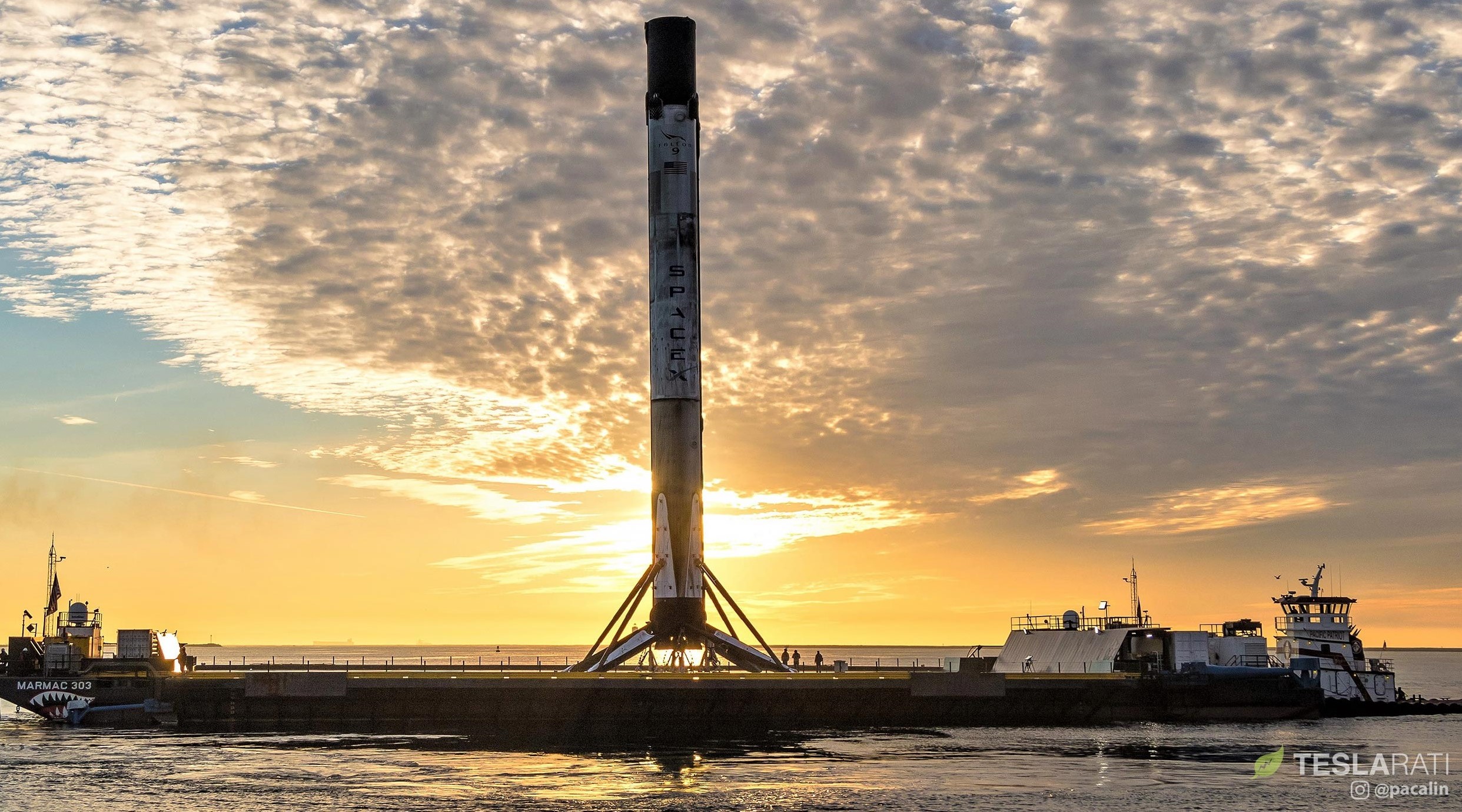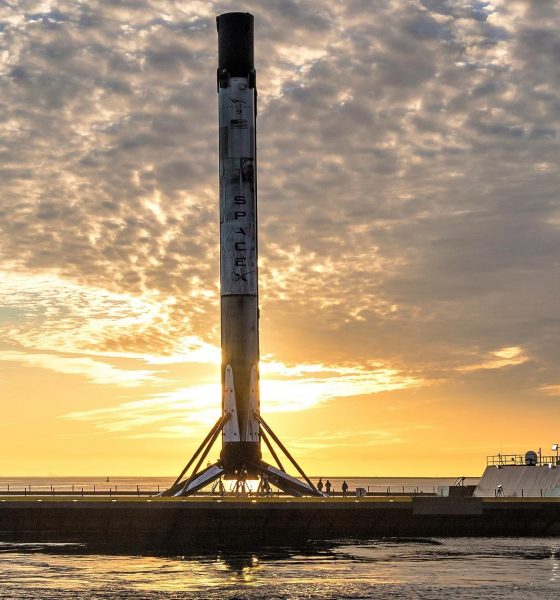

News
SpaceX Falcon 9 booster returns to California port for the first time in years
For the first time in almost three years, a SpaceX Falcon 9 booster has returned to a California port after a successful West Coast launch and landing.
On September 16th, 2021, less than three days after successfully launching SpaceX’s first West Coast Starlink mission and helping orbit the first batch of 51 upgraded Starlink satellites with ‘space lasers,’ Falcon 9 booster B1049 sailed into the Port of Long Beach. Riding on drone ship Of Course I Still Love You (OCISLY), B1049’s arrival is the first time a SpaceX rocket has returned to a California port since January 2019 – 32 months ago.
If SpaceX’s Starlink V1.5 manufacturing is up to the task, though, there may never again be such a substantial gap between West Coast booster returns – or launches, for that matter.
In a coincidental and perhaps fitting bit of symmetry, it was actually Falcon 9 booster B1049 that last returned to Port of Los Angeles on January 13th, 2019 and then ended the almost three-year West Coast drone ship recovery hiatus on September 16th, 2021. In September 2018, almost exactly three years ago, B1049 – the fourth upgraded Block 5 booster built by SpaceX – launched for the first time.
Iridium-8 – SpaceX’s last West Coast drone ship recovery until this week – was the booster’s second mission. While not quite as spry as its newer siblings, B1049 nevertheless managed to support seven more orbital launches before it returned to Vandenberg Air (now Space) Force Base for flight #10 – becoming the second SpaceX booster ever to reach double digits in the process. Falcon 9 B1049 is now the oldest living booster in SpaceX’s fleet and has averaged one launch every 100 days over its storied three-year life.
Falcon 9 B1051, SpaceX’s other ten-flight booster, has managed a slightly better average of one launch every ~80 days. However, newer boosters B1058 and B1060 have absolutely smashed the records of their predecessors, achieving an average of one launch every 45 days over their eight-flight careers.
Ultimately, SpaceX is expected to operate two or three Falcon boosters out of VAFB to support an average cadence of as many as 12 polar or semi-polar Starlink launches per year – hopefully beginning with Starlink 2-1 on September 13th. According to Spaceflight Now, SpaceX is also preparing to restart East Coast Starlink launches – likely to similar semi-polar orbits – as early as October. With any luck, SpaceX’s Starlink factory will be able to get back into its stride and ramp up V1.5 satellite production to match or exceed the ~120 V1.0 satellites it was recently building each month.
Stay tuned for updates on SpaceX’s next Starlink launch – both from the East Coast and West Coast.

News
Tesla FSD fleet is nearing 7 billion total miles, including 2.5 billion city miles
As can be seen on Tesla’s official FSD webpage, vehicles equipped with the system have now navigated over 6.99 billion miles.

Tesla’s Full Self-Driving (Supervised) fleet is closing in on almost 7 billion total miles driven, as per data posted by the company on its official FSD webpage.
These figures hint at the massive scale of data fueling Tesla’s rapid FSD improvements, which have been quite notable as of late.
FSD mileage milestones
As can be seen on Tesla’s official FSD webpage, vehicles equipped with the system have now navigated over 6.99 billion miles. Tesla owner and avid FSD tester Whole Mars Catalog also shared a screenshot indicating that from the nearly 7 billion miles traveled by the FSD fleet, more than 2.5 billion miles were driven inside cities.
City miles are particularly valuable for complex urban scenarios like unprotected turns, pedestrian interactions, and traffic lights. This is also the difference-maker for FSD, as only complex solutions, such as Waymo’s self-driving taxis, operate similarly on inner-city streets. And even then, incidents such as the San Francisco blackouts have proven challenging for sensor-rich vehicles like Waymos.
Tesla’s data edge
Tesla has a number of advantages in the autonomous vehicle sector, one of which is the size of its fleet and the number of vehicles training FSD on real-world roads. Tesla’s nearly 7 billion FSD miles then allow the company to roll out updates that make its vehicles behave like they are being driven by experienced drivers, even if they are operating on their own.
So notable are Tesla’s improvements to FSD that NVIDIA Director of Robotics Jim Fan, after experiencing FSD v14, noted that the system is the first AI that passes what he described as a “Physical Turing Test.”
“Despite knowing exactly how robot learning works, I still find it magical watching the steering wheel turn by itself. First it feels surreal, next it becomes routine. Then, like the smartphone, taking it away actively hurts. This is how humanity gets rewired and glued to god-like technologies,” Fan wrote in a post on X.
News
Tesla starts showing how FSD will change lives in Europe
Local officials tested the system on narrow country roads and were impressed by FSD’s smooth, human-like driving, with some calling the service a game-changer for everyday life in areas that are far from urban centers.

Tesla has launched Europe’s first public shuttle service using Full Self-Driving (Supervised) in the rural Eifelkreis Bitburg-Prüm region of Germany, demonstrating how the technology can restore independence and mobility for people who struggle with limited transport options.
Local officials tested the system on narrow country roads and were impressed by FSD’s smooth, human-like driving, with some calling the service a game-changer for everyday life in areas that are far from urban centers.
Officials see real impact on rural residents
Arzfeld Mayor Johannes Kuhl and District Administrator Andreas Kruppert personally tested the Tesla shuttle service. This allowed them to see just how well FSD navigated winding lanes and rural roads confidently. Kruppert said, “Autonomous driving sounds like science fiction to many, but we simply see here that it works totally well in rural regions too.” Kuhl, for his part, also noted that FSD “feels like a very experienced driver.”
The pilot complements the area’s “Citizen Bus” program, which provides on-demand rides for elderly residents who can no longer drive themselves. Tesla Europe shared a video of a demonstration of the service, highlighting how FSD gives people their freedom back, even in places where public transport is not as prevalent.
What the Ministry for Economic Affairs and Transport says
Rhineland-Palatinate’s Minister Daniela Schmitt supported the project, praising the collaboration that made this “first of its kind in Europe” possible. As per the ministry, the rural rollout for the service shows FSD’s potential beyond major cities, and it delivers tangible benefits like grocery runs, doctor visits, and social connections for isolated residents.
“Reliable and flexible mobility is especially vital in rural areas. With the launch of a shuttle service using self-driving vehicles (FSD supervised) by Tesla in the Eifelkreis Bitburg-Prüm, an innovative pilot project is now getting underway that complements local community bus services. It is the first project of its kind in Europe.
“The result is a real gain for rural mobility: greater accessibility, more flexibility and tangible benefits for everyday life. A strong signal for innovation, cooperation and future-oriented mobility beyond urban centers,” the ministry wrote in a LinkedIn post.
News
Tesla China quietly posts Robotaxi-related job listing
Tesla China is currently seeking a Low Voltage Electrical Engineer to work on circuit board design for the company’s autonomous vehicles.

Tesla has posted a new job listing in Shanghai explicitly tied to its Robotaxi program, fueling speculation that the company is preparing to launch its dedicated autonomous ride-hailing service in China.
As noted in the listing, Tesla China is currently seeking a Low Voltage Electrical Engineer to work on circuit board design for the company’s autonomous vehicles.
Robotaxi-specific role
The listing, which was shared on social media platform X by industry watcher @tslaming, suggested that Tesla China is looking to fill the role urgently. The job listing itself specifically mentions that the person hired for the role will be working on the Low Voltage Hardware team, which would design the circuit boards that would serve as the nervous system of the Robotaxi.
Key tasks for the role, as indicated in the job listing, include collaboration with PCB layout, firmware, mechanical, program management, and validation teams, among other responsibilities. The role is based in Shanghai.
China Robotaxi launch
China represents a massive potential market for robotaxis, with its dense urban centers and supportive policies in select cities. Tesla has limited permission to roll out FSD in the country, though despite this, its vehicles have been hailed as among the best in the market when it comes to autonomous features. So far, at least, it appears that China supports Tesla’s FSD and Robotaxi rollout.
This was hinted at in November, when Tesla brought the Cybercab to the 8th China International Import Expo (CIIE) in Shanghai, marking the first time that the autonomous two-seater was brought to the Asia-Pacific region. The vehicle, despite not having a release date in China, received a significant amount of interest among the event’s attendees.








